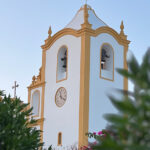As summer ends and the weather begins to turn, a wave of birds sweeps across Europe, from north to south. Sagres is a prime place to enjoy this awe-inspiring display.
WORDS Sonia Neves/SPEA
In September and October, thousands of birds fly over the Algarve on their way to wintering grounds in Africa. On land, bushes and trees are stopping points for small songbirds looking to make the ambitious journey south. Among the latter is the common redstart, featured on the poster for this year’s edition of the annual celebration of bird migration in the region: the Birdwatching & Nature Activities Festival.
When switching between English and Portuguese, this species’ name can cause some confusion. In Portuguese, rabirruivo-comum (‘common redstart’) or simply rabirruivo (‘redstart’) refers to the black redstart. The species known as common redstart or redstart in English is called rabirruivo-de-testa-branca (‘white-foreheaded’ redstart), after its white forehead, which stands out against the adult male’s dark head.
This apparent discrepancy stems from the fact that in Portugal, unlike the UK, the black redstart can be seen all year round and, having adapted to humans, is often seen in cities – making it easier to spot and earning it the ‘common’ epithet in Portuguese. The common redstart, on the other hand, only visits Portugal in the spring/summer to breed or pass by during the autumn migration, and even then, it spends most of its time in trees and bushes, making it much harder to spot.
If you do see this elegant songbird in a tree or bush, you’ll notice it perches very straight and wiggles its ginger tail. In autumn, the common redstarts that nest in Portugal are joined by others from the north – all head to Africa for the winter, and many pass through Sagres. Most of these passersby are juvenile birds – notable by the absence of the adult males’ characteristic dark head – who haven’t yet learned that the best route to Africa is via Gibraltar.
The common redstart is just one of the dozens of species which visit the trees, bushes and hedges around Sagres every autumn. Some are just passing by en route to warmer climes, while others will take refuge here all winter. Overhead, eagles, storks and vultures ride the thermals, searching for the winds that will enable them to soar to Africa. Every year, over 4000 soaring birds – belonging to all species have been recorded.
Meanwhile, out at sea, thousands of seabirds fly by off the coast, some of them on epic journeys from pole to pole. You need to go on a boat trip to see some of them, but others can be spotted easily from land: in October, thousands of Northern Gannets can fly past Cabo de S. Vicente in just one hour.
To make the most of this birdwatchers’ bounty and discover the incredible nature of this region, join some of the over 200 activities at the Birdwatching & Nature Activities Festival.
Photo © Diogo Oliveira

Registration is open online at birdwatchingsagres.com













